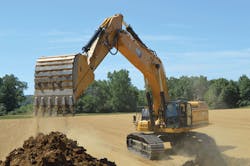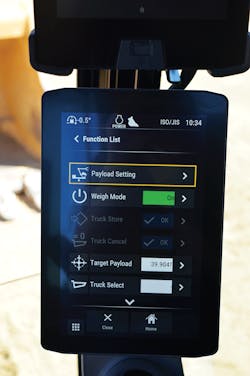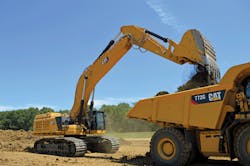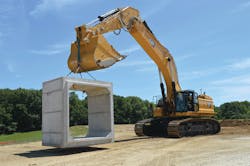How does the “Next Generation” 395 Caterpillar excavator perform?
We asked Todd Shreves and Mike High, operator/instructors from the Independent Union of Operator Engineers Local 649 in Bartonville, Illinois, to answer that question. The two excavator veterans came to Caterpillar’s Edwards Demonstration & Learning Center to work the machine and decide for themselves. The Edwards site was used because transport costs for the big unit were prohibitive, even for the short journey from north of Peoria to Bartonville.
This high-production model replaces the Cat 390F, which debuted in 2013. It has more horsepower, more weight, more steel, more technology, and is designed for higher performance than its predecessor, Cat says. The operator/instructors’ mission for the warm summer day was to dig deep trenches into Central Illinois clay, swing to load a rigid-frame dumper, and lift and move a 35,000-pound box culvert.
Weighing in at 207,000 pounds, the 395 uses a Cat C18 engine that generates 542 net horsepower, up from the 390F’s 524. The 395 is aimed at quarry work, stripping overburden, large sewer projects, and mass excavation earthwork.
“This is a bigger, stronger, faster machine from what we previously had,” says Ryan Neal, Caterpillar’s large excavator product specialist for North America with responsibility from Cat’s 336 to the 395. “Customers are always wanting more and more. They want bigger buckets, bigger counterweights, and more stability so they can be more productive.”
The 395 indeed has more counterweight (34,000 pounds) and stronger structures and frames, as well as the ability to add larger buckets such as the 6.8-cubic-yard bucket on the test machine. The boom and stick have been specifically beefed up.
“When you look at a lot of places that do hard rock digging with a lot of abrasive material, we have to make sure the front structures are going to last, so what we’ve done is put two times more durability for the boom and stick, all the way into the frame,” Neal says. “That basically comes out to something simple—we added more steel to it. The plates on the top and bottom, and the baffles inside are thicker than the 390F. The whole carbody and frame is two times more durable than what we were getting out of the 390F.”
The large counterweight is not only meant to counteract the additional weight in the front of the machine, but it’s also key to allowing larger bucket sizes.
“We want customers to be able to put bigger spoons on this,” Neal says. “The bigger buckets you have on, the more productive you can potentially be.”
The unit’s stick cylinder and bucket cylinder forces have also been increased for more breakout force.
Unlike some of Cat’s smaller excavators guided by pilot controls, the 395 has electric over hydraulic controls. “We’ve tried to do a really good job of keeping the pilot feel,” Neal says. “It allows us to do all the technology and the tuning, and make it really easy to do without having to get into the pumps and change a lot of things in the cab itself. That also gives us the ability to do the grade control with E-Fence, to get the hydraulics to stop where we want them to stop.”
As the Local 649 operators climbed into the cab, the controls were the first thing they were curious about.
“I was concerned about the newer controls, the electric over hydraulics, but they felt really good,” Shreves says. “The swing was really responsive. When I was swinging, it’s got a small swing break on it to slow you down enough that I could overcorrect. With the bucket on it, you’re talking over 30,000 pounds of momentum. But you can still feel some ‘feel.’ I know it’s all electric, but you could still feel the machine when it would catch on a dig and when you have to come up a little bit to load the bucket. They’ve done something well with the controls.”
Caterpillar also made big changes to the layout of the excavator, primarily for maintenance. “We flip-flopped the cooling package and the pump,” Neal says. “Typically, the pump is on the opposite side. A big reason we’ve done that is for operator safety. We’ve moved everything to the operator side.”
There’s also a bright light for the entire platform. Coolant, washer fluid, and the battery can be checked behind one door, and fuel, hydraulic, and air filters, as well as the oil check, is behind another.
“I really liked the motor being so far back from the cab; I could only hear the machine a little bit,” High says. “And I liked the setup of having everything on the right side and being able to walk along the side rather than go up top for maintenance.”
In addition, Caterpillar has gone back to a dedicated swing pump for the 395. “We’re not using any of the front structures to get the machine to swing,” Neal says. “The 390F was seeking fuel efficiency, so we got away from it. Now, we’re back without losing any efficiency. It’s like a high-stat closed circuit—if you ask for swing, no matter what you’re doing, you’re going to get swing.”
The machine features three work modes, Power mode, Smart mode, and Eco mode. Neal points out a key differentiator. “We do the opposite of what a lot of [companies] do, which means we start on high power, but we’re constantly reading the joystick input, the engine input, and the hydraulic input,” he says.
“So if you start on high power and you’re just cleaning up, fluffing and cleaning around hydrants, maybe, you don’t need all the power,” Neal says. “So it will reduce the rpm for you, but as soon as you start asking for it, you start cranking levers and loading trucks again, it ramps back up.”
High tried all the 395’s modes. “I started in the regular Power mode to see how it would feel running full bore. Then I switched to the Smart mode and I could definitely feel the difference when I was just cleaning off the top of the ditch,” he says. “Granted I was pulling mostly air, and just taking a little bit of the dirt off. But you could feel those handles power down a little bit, and as soon as I got into the heavy stuff, it would take right off again. I tried Eco mode on my third cut, and you could tell a slight power loss, but I don’t see there being a big difference between the Power and the Eco mode. It didn’t feel like a big difference.
“I would probably use the Smart mode, myself,” High says. “Working for contractors that don’t run equipment, they want to hear it running wide open all the time. As far as me running it, I would probably run it in Smart mode as long as I had a good handle on the electric over hydraulic, as long as I’m in sync. I think it would be better in the long run.”
Performance isn’t the only hallmark of the 395. All Cat Next Generation excavators come with more standard technology features than their predecessors.
The standard Cat Payload feature gives operators real-time visibility to their production. The system calculates the weight of the material in the bucket and the number of tons moved per day, along with keeping track of the number of trucks loaded. And operators can access the information without an Internet connection or a subscription to Cat’s VisionLink telematics system.
“Tons per hour, gallons per hour: It’s keeping track of that information all day long, on the machine,” Neal says.
Cat Grade with 2D is also standard. It gives operators visual guidance to help make grade via the touchscreen. “The 2D grade is indicate only,” Neal says. “Meaning if we have to dig down 28 feet, I can tell the monitor from where the bucket teeth are ‘negative 28’ and it will indicate when I’m at that grade. If I need to put a slope in there, if I’m doing sewer work, and I need a fall, plus or minus, we can tell that in the machine. Every time the machine moves, you re-bench and reset.”
The system is upgradeable to Cat Grade with Advanced 2D or Cat Grade with 3D. Advanced 2D comes with another monitor for in-field design. The 3D system adds GPS and GLONASS positioning for accuracy. Built-in communication technology also allows connection to 3D services such as Trimble Connected Community or Virtual Reference Station.
“I haven’t been around GPS much, but I sat on a 336E most of the summer and fall; that was pretty easy, so the old type, I had no problem with that,” High says “But this new system, I like having everything right there on the monitor, available. I can push and hold on it, it pops up, or I can swipe; I really like that. Like any new system, I’m interested to see how it does after a couple of years.
“As far as running it [through the monitor], I thought that would be a distraction sitting over there, as big as it is,” High says. “But it’s nice being big enough that I can just glance over. With some of the smaller screens, when you get older, you can’t see as well. You’ve got to search for stuff. With this monitor being bigger, you get a real good picture of it.”
Though a software glitch prevented operators from using the Lift Assist safety feature during the Field Test, the 395 comes standard with the technology that calculates the weight of the actual load being lifted and compares it to the excavator’s rated capability. Visual and audible alerts show and tell the operator if the excavator is within a safety working range. “The lift chart that you often see on the side of the window, we’ve digitized that,” Neal says. “If need be, it will also tell you the direction to move the boom to reduce the load.”
High feels the feature would be valuable. “It’s nice, because for the guys who have trouble saying ‘No’ to a lift, it takes that right out of their hands.”
Another standard tech feature is 2D E-Fence, which is designed to prevent the excavator from moving outside operator-defined points, handy for working under power lines or in a skeleton building. Neal says parameters can be set to control distances for reach, height, swing, and possible contact with the cab when handling items like concrete slabs or tree stumps.
This particular 395 was equipped with a 360-degree visibility package (including premium LED lighting) that combines images from four cameras. “The visibility on the cameras is phenomenal, they really work great,” Shreves says. “They’re user-friendly, so even a guy like me can figure out how to swipe the screen and pull up the camera view I want to see.”
Like the cameras, all of the technology features are controllable and viewable from the large, 10-inch touchscreen monitor placed on the operator’s right. The Local 649 operator/instructors gave it high marks.
“The pad itself was touch-friendly,” Shreves says. “It’s not always that way on some of the phones or different screens we use.”
High, in particular, was impressed. “One thing I noticed with those screens, I’ve got prescription sunglasses where it cuts the brightness down, and a lot of times with my phone, or with some screens like on the E models, you get dark spots. And I always thought the camera was dirty, until I raised up my glasses once and realized, ‘Oh, it’s these.’ And that screen today was just as clear with polarized glasses as if I was looking through regular sunglasses.”
Overall, both operator instructors were impressed with the excavator’s amenities and performance, particularly noting its size.
“Other than the fact that sitting in the cab feels familiar, because of the controls and the finesse with them, I didn’t feel like I was in a big machine,” Shreves says. “I was surprised how well it felt for a big machine. The bigger machines I’ve run have not handled as well. It felt like a smaller machine to me. You forget its size until you go out and stand beside that pile of dirt you just dug up.”
High agrees.
“In the big machines I’ve run in the past, it just felt like you were sitting way up in the air and everything’s big, slow, and lumbering; they just didn’t have the feel,” he says. “This felt almost like a medium-class machine. You know it’s going to run a little slower for the size that it is, but I feel like the reaction and the control surprised me. It felt to me like a 345-sized machine.”
Want more Field Tests?
About the Author
Frank Raczon
Raczon’s writing career spans nearly 25 years, including magazine publishing and public relations work with some of the industry’s major equipment manufacturers. He has won numerous awards in his career, including nods from the Construction Writers Association, the Association of Equipment Manufacturers, and BtoB magazine. He is responsible for the magazine's Buying Files.




